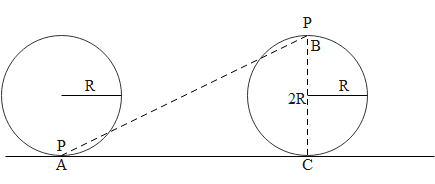
Given that P is a point on a wheel rolling on a horizontal ground. The radius of the wheel is R. Initially if the point P is in contact with the ground, the wheel rolls through half revolution. What is the displacement of point P?
\[
{\text{A}}{\text{. }}R\sqrt {{\pi ^2} + 1} \\
{\text{B}}{\text{. }}R\sqrt {{\pi ^2} + 4} \\
{\text{C}}{\text{. }}\pi R \\
{\text{D}}{\text{. 2}}\pi R \\
\]
Answer
554.1k+ views
Hint: First we need to draw a diagram which shows the wheel before and after the half revolution and the change in the position of point P. After the half revolution, point P will reach the top of the wheel and by analysing the diagram and known values, we can get the required answer.
Complete answer:

We are given a wheel which is rolling on a horizontal ground as shown in the figure. The radius of the wheel is R. The diagram shows that initially point P is in contact with the ground. Then the wheel rolls through half revolution and the right wheel in the diagram shows the wheel after this half revolution. This means that the wheel covers a distance which is equal to the half of the circumference of the given wheel. So the distance AC can be written as
\[AC = \pi R\]
The length BC is equal to the diameter of the wheel and is given as
$BC = 2R$
The displacement of point P will be equal to the length AB which can be calculated using the Pythagoras theorem in the following way.
$AB = \sqrt {A{C^2} + B{C^2}} $
Now inserting the known values, we get
$AB = \sqrt {{{\left( {\pi R} \right)}^2} + {{\left( {2R} \right)}^2}} = R\sqrt {{\pi ^2} + 4} $
This is the required value of the displacement of the point P.
Hence, the correct answer is option B.
Note:
It should be noted that displacement means the shortest distance between the initial and the final position of point P. If we talk about the distance travelled by point P then we will have to consider the half revolution which took P from A to B. The displacement is simply a straight line drawn between the initial and the final position.
Complete answer:

We are given a wheel which is rolling on a horizontal ground as shown in the figure. The radius of the wheel is R. The diagram shows that initially point P is in contact with the ground. Then the wheel rolls through half revolution and the right wheel in the diagram shows the wheel after this half revolution. This means that the wheel covers a distance which is equal to the half of the circumference of the given wheel. So the distance AC can be written as
\[AC = \pi R\]
The length BC is equal to the diameter of the wheel and is given as
$BC = 2R$
The displacement of point P will be equal to the length AB which can be calculated using the Pythagoras theorem in the following way.
$AB = \sqrt {A{C^2} + B{C^2}} $
Now inserting the known values, we get
$AB = \sqrt {{{\left( {\pi R} \right)}^2} + {{\left( {2R} \right)}^2}} = R\sqrt {{\pi ^2} + 4} $
This is the required value of the displacement of the point P.
Hence, the correct answer is option B.
Note:
It should be noted that displacement means the shortest distance between the initial and the final position of point P. If we talk about the distance travelled by point P then we will have to consider the half revolution which took P from A to B. The displacement is simply a straight line drawn between the initial and the final position.
Recently Updated Pages
Why are manures considered better than fertilizers class 11 biology CBSE

Find the coordinates of the midpoint of the line segment class 11 maths CBSE

Distinguish between static friction limiting friction class 11 physics CBSE

The Chairman of the constituent Assembly was A Jawaharlal class 11 social science CBSE

The first National Commission on Labour NCL submitted class 11 social science CBSE

Number of all subshell of n + l 7 is A 4 B 5 C 6 D class 11 chemistry CBSE

Trending doubts
What is meant by exothermic and endothermic reactions class 11 chemistry CBSE

10 examples of friction in our daily life

One Metric ton is equal to kg A 10000 B 1000 C 100 class 11 physics CBSE

1 Quintal is equal to a 110 kg b 10 kg c 100kg d 1000 class 11 physics CBSE

Difference Between Prokaryotic Cells and Eukaryotic Cells

What are Quantum numbers Explain the quantum number class 11 chemistry CBSE




